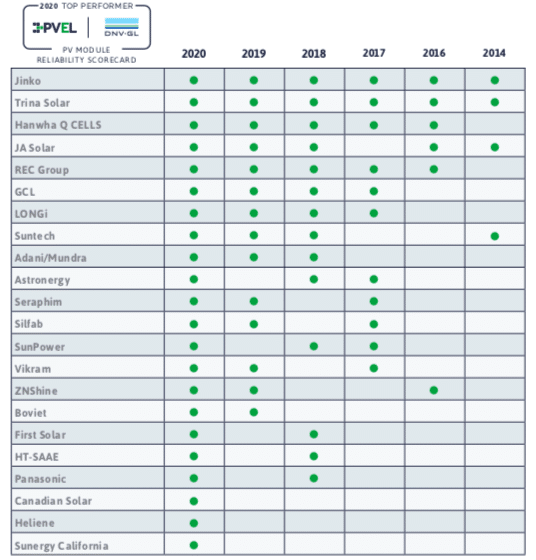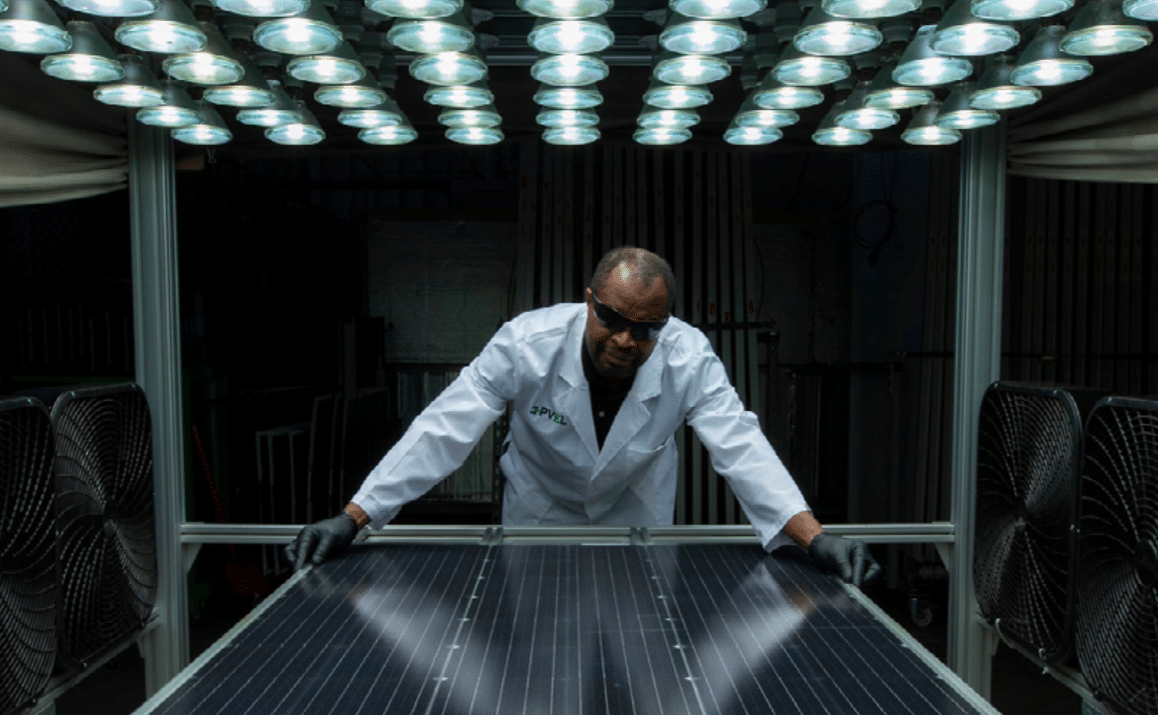PV Evolution Labs (PVEL), a test lab for the downstream solar market, just published its PV Module Reliability Scorecard.
The reliability report report reveals some new “top performers” compared to last year — but, it also shows that some manufacturers “overlooked minimum safety and quality controls in the rush to bring innovative PV cell and module technologies to market.”
Here are the solar vendors that make it onto the test labs “top performer” list.

Flood of solar cell and module advancements
PVEL’s CEO Jenya Meydbray notes the crowd of solar module options and advancements:
- 8 different cell sizes: 125mm, 156mm, 156.75mm, 157.25mm, 158.75mm, 161.7mm, 162mm, 166mm
- 8 different cell technologies: p-type mono Al-BSF, p-type multi and mono PERC, n-type mono PERT, HJT n-type mono, p-type bifacial mono PERC, n-type bifacial mono PERT, CdTe
- Cells with 5 different counts of busbars 3, 5, 6, 9, 12
- Monofacial and bifacial glass-glass modules
- Monofacial and bifacial glass-backsheet modules
- 4 different cell interconnection types: Standard ribbons, ECA (shingled), interdigitated backcontact, metal wrap-through
- Half- cut and shingled cells, novel cell-to-cell interconnect methods.
- Thinner frames and glass, light-reflecting ribbon, novel encapsulants and backsheets.
Meydbray notes, “In this rush to innovate, some manufacturers have overlooked basic quality control.”
Three trends in PV module technology and their risks
PVEL has observed three important trends in PV module technology that are “particularly important for downstream stakeholders to consider from a risk-mitigation perspective.”
Large-scale adoption of PERC cell architectures: Passivated emitted rear contact (PERC) cells have quickly replaced the once-dominant aluminum back surface field cells. Although PERC cells are higher efficiency and can perform better in low-light and high-temperature conditions, some PERC cells are susceptible to light and elevated temperature induced degradation.
New cell designs: more busbars, new types of interconnect wires, various wafer sizes, as well as half-cut or smaller cells are driving higher efficiencies. “Some new cell designs are more susceptible to microcracks and may require process changes on manufacturing lines that can lead to increased defect rates,” according to PVEL.
New module designs: PV module manufacturers are introducing lighter weight modules, bifacial options, and physically larger modules. “Newer module form factors may be more susceptible to damage, and they may not be compatible with existing mounting systems,” claims the lab.
Resurgence of known failure mechanisms
As manufacturers rush to bring new technologies to market, PVEL is observing “a resurgence of known failure mechanisms,” along with new degradation modes.
This year, the median PID (potential induced degradation) in PVEL’s testing “was the highest it has ever been in the lab’s history. PID is a problem that many in our industry regarded as solved. Its resurgence is troubling, as are many of the other failures recorded in this report,” writes the CEO in the report.
Tara Doyle, chief commercial officer of PVEL notes that new bills of materials have “yielded surprising results for some vendors,” adding that some manufacturers thought that they had a “PID resistant bill of materials” but found out otherwise.
“A diverse array of PV technologies has upended conventional R&D timelines to achieve rapid commercialization, leading PVEL to test more cell and module combinations for our 2020 Scorecard than at any point in our ten-year history,” noted Doyle.
“Developers and investors need independent, reliable data to balance the reliability risks inherent to new products against the promise of higher-performing, more lucrative projects.”
There’s enough test data in the PVEL report for a number of articles — so consider this the first of a series. Download the 2020 PV Module Reliability Scorecard here.
This content is protected by copyright and may not be reused. If you want to cooperate with us and would like to reuse some of our content, please contact: editors@pv-magazine.com.








By submitting this form you agree to pv magazine using your data for the purposes of publishing your comment.
Your personal data will only be disclosed or otherwise transmitted to third parties for the purposes of spam filtering or if this is necessary for technical maintenance of the website. Any other transfer to third parties will not take place unless this is justified on the basis of applicable data protection regulations or if pv magazine is legally obliged to do so.
You may revoke this consent at any time with effect for the future, in which case your personal data will be deleted immediately. Otherwise, your data will be deleted if pv magazine has processed your request or the purpose of data storage is fulfilled.
Further information on data privacy can be found in our Data Protection Policy.